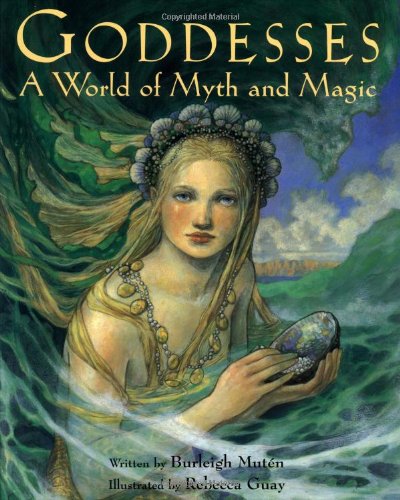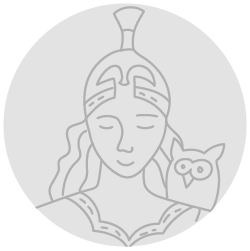Title of the work
Country of the First Edition
Country/countries of popularity
Original Language
First Edition Date
First Edition Details
Burleigh Mutén, Goddesses: A World of Myth and Magic. Cambridge, MA: Barefoot Books, 2003, 81 pp.
ISBN
Genre
Mythological fiction
Teen fiction*
Target Audience
Crossover (adolescents)
Cover

Photo courtesy of the author Burleigh Mutén, the artists Rebecca Guay and the publisher, Barefoot Books.
Author of the Entry:
Ayelet Peer, Bar-Ilan University, ayelet.peer@biu.ac.il
Peer-reviewer of the Entry:
Lisa Maurice, Bar-Ilan University, Lisa.maurice@biu.ac.il
Elizabeth Hale, University of New England, ehale@une.edu.au

Rebecca Guay by Luigi Novi, 2011. Retrieved from Wikipedia, licensed under CC BY 3.0 (accessed: January 25, 2022) © Luigi Novi / Wikimedia Commons.
Rebecca Guay (Illustrator)
Rebecca Guay is an award-winning American painter and illustrator. She is the creator of art for video games and role-playing games. In 1992 she received her degree in Illustration from the Pratt Institute in New York City. She has worked for Marvel and DC Comics and various animation studios. She is recently focused on her gallery works for which she has been granted several awards.
Bio prepared by Ayelet Peer, Bar-Ilan University, ayelet.peer@biu.ac.il

Burleigh Mutén (Author)
Burleigh Mutén is an American writer and editor. She lives in Amherst Massachusetts, where she also offers writing workshops for children and adults, as well as being a tour guide for the Emily Dickinson Museum. She has written about Emily Dickinson.
Among her books are: Miss Emily, Her Words, The Lady of Ten Thousand Names.
Source:
Official website (accessed: August 20, 2020).
Bio prepared by Ayelet Peer, Bar-Ilan University, ayelet.peer@biu.ac.il
Summary
As its title suggests, this book offers brief informational entries on various goddesses from different cultures around the world: Africa, Asia, Europe, Near East, North America, South and Central America, Oceania and Polynesia. The information is alphabetically organized, with accompanying original illustrations. For each goddess we have her name, spelling guide, origin, and one passage which describes her role and attributes. It is also mentioned whether the goddess is still worshiped today (for example the Indian Saravasti). The Greek goddess who are mentioned in the book are: Aphrodite, Artemis, Athena, Britomartis, Cybele, Demeter, Echo, Eirene, Eurynome, Gaia, The Graces, The Graeae, Hekate, Hera, Hestia, Iris, Medusa, The Muses, Nike, Pandora, Persephone, Themis. The Italian goddesses are Epona, Fortuna, Juno, Ops, Vesta.
At the end of the book there is a bibliography of modern research with which the author consulted.
Analysis
In the introduction, the author notes that, growing up in the 1950s, she was greatly influenced by the independent spirit of Artemis. She writes “maybe I loved Artemis because she defied the authority of her father and insisted on having her own way. What child isn’t attracted by independence?...the stories about Artemis inspired me to think for myself, to believe that I was strong like her…”
It is obvious how important the Greek goddess was to the author and how she clearly empowered her and inspired her to continue to explore the world of goddesses in different cultures. Hence the author aims to empower her young (female yet also male) readers with the tales of goddesses form around the world.
The goddesses on this book are presented in a favourable light for the most part, with only brief indications of their related myths, if any. For example, in the passage on Demeter, it is noted that her daughter was kidnapped by Hades which caused Demeter to stop blessing the crops.
Aphrodite, however, is depicted as “known to be vain and jealous” (p. 7) despite the fact that one could relate jealousy to the other goddesses as well.
The author makes associations between the Greek, Cretan and Roman goddesses. For example she explains that Britomartis was known as Artemis in Greece and gives the Roman names for the different Greek goddesses. The author is not only interested in the goddesses but in other minor deities (like the nymph Echo) or monsters, such as the Graces or Medusa.
As mentioned, the author focuses on the positive aspects of the goddesses and adapts her description accordingly. This is especially visible in the portrayal of Medusa. She describes her as one of the Gorgons bur as beautiful with “gleaming gold wings and...long golden hair that twirled into serpentine ringlets.” (p. 46). This is a sharp contrast from the more common depictions of the gorgon especially on vase painting or on Athena’s aegis. (Only Pseudo-Apollodorus mentions that the gorgon Medusa was beautiful. For the source see here, accessed: August 20, 2020. He also describes their wings as golden). Perhaps the author was combining here the myth of the beautiful mortal woman Medusa with the gorgon Medusa. She also adds that her blood was used to revive the dead (in Ovid’s Metamorphoses 4.770 her blood creates snakes but again Pseudo-Apollodorus notes it could revive the dead; see the source above). However, Pseudo-Appollodorus by himself is not listed in the sources at the end of the book, therefore we may assume his version was used by a modern researcher which the author used, perhaps Robert Graves’ book or others.
To conclude, the book offers a unique glimpse at the centrality and importance of goddesses and divinities in different cultures; showing that they are indeed the strong gender.
The book is accompanied by colourful illustrations of the various goddesses, which depict most of them as young, slender and beautiful. Some are portrayed as older (the Graeae, Elli) for some their attributes are portrayed, as sacred animals, mountains, water, flowers.


